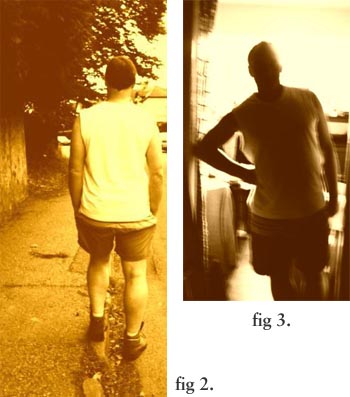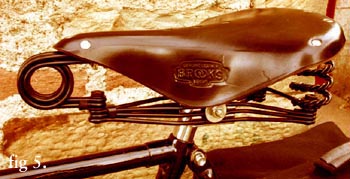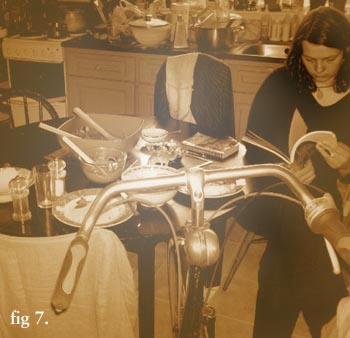[ 63XC.COM | STORIES | FLANN LIVES! ]
On Flann O'Brien's The Third Policeman
It is possible that among the readers of these pages there are some as yet unfamiliar with the works of Flann O'Brien. Flann O'Brien was one of a series of pen-names adopted by the Irish writer Brian O'Nolan (1911-1966) during a long and complex career in which he was civil servant, journalist, novelist and playwright, sometimes all at the same time. Cyclists will find references to their favourite mode of transportation dispersed throughout his work, but the posthumously-published novel The Third Policeman, perhaps the only work of literature in which the romantic lead is played by a bicycle, will be of particular interest. It offers a succinct presentation of the debate between modernity and conservatism in the matter of componentry and riding style, along with a singular insight into the physics and metaphysics of human-bicycle relations. In this brief essay, I intend to set out the main themes of the book and to indicate their continued relevance to the contemporary rider. A call to self-reflection: am I a bicycle? As a mental exercise in preparation for further reading, please take a moment or two to reflect.
When out of the saddle, do you or your cycling friends spend a lot of time leaning with one elbow on walls (fig.1) or standing propped by one foot at kerbstones? (fig.2) Do you walk smartly always and never sit down? Do you lean against the wall with your elbow out and stay like that all night in the kitchen instead of going to bed? (fig. 3)
If you walk too slowly or stop in the middle of the road do you fall down in a heap and have to be lifted and set in motion again by some extraneous party? (fig. 4)
You do? Then read on, if you value your life. The Rules of Wisdom The concerned reader could do worse than to observe the five rules of wisdom, as set out near the beginning of the book by Sergeant Pluck, not the eponymous Third Policeman - whose name is Fox - but rather the first: 1. Always ask any questions there are to be asked and never answer any; If you observe these tenets faithfully, according to the Sergeant, "you will save your soul and you will never get a fall on a slippy road." Sapient Dialectic We encounter more of the Sergeant's views in Chapter 6, where he emerges as the voice of conservatism in cycling matters in the course of an elegant dialectic he conducts with Michael Gilhaney while engaged in the search for Gilhaney's stolen bicycle. Gilhaney emerges as an uncompromising modernist with one sole criterion for utility: the three-speed gear, rat-trap pedals and the high saddle are all lauded as "a power for the hills" whereas the timber rim (praised by the Sergeant as "a very commendable invention, it gives you more of a bounce, it is extremely easy on your white pneumatics") is condemned as "a death trap in itself, it swells on a wet day and I know a man that owes his bad wet death to nothing else". The Sergeant, on the other hand, excoriates the three speed gear - "a new-fangled instrument, it crucifies the legs, the half of the accidents are due to it...a hard thing to tune, you can screw the iron lace that hangs out of it till you get no catch at all in the pedals."* He opines that "if rat-trap pedals were universal it would be the end of bicycles, the people would die like flies" and suggests they be "made specialities like arsenic when you would have to buy them at a chemist's shop and sign a little book and look like a responsible personality". He is no less harsh in his condemnation of the high saddle: "the high saddle was the father of the low handlebars. It crucifies the fork and gives you a blood rush to the head, it is very sore on the internal organs". When the narrator asks "which of the organs?" the sergeant replies, "Both of them" (a succinct summation of the 2003 Bicycle Saddle Report, commented on at greater length elsewhere on this very site). Atomic Theory: are you safe from it? During this exposition, the Sergeant has been adroitly recovering various accessories belonging to Gilhaney's stolen bicycle and ultimately the machine itself. After the departure of Gilhaney, he reveals to the narrator the secret of his constabulary virtuosity, namely that he stole the bicycle himself and planted all the clues. His explanation of why he did so leads us into new and startling territory with his exposition of the Atomic Theory. This can be summarised in the Sergeant's own words as follows: 1. "Everything is composed of small particles of itself and they are flying around in concentric circles and arcs and segments and innumerable other geometrical figures too numerous to mention collectively, never standing still or resting but spinning away and darting hither and thither and back again, all the time on the go. These diminutive gentlemen are called atoms..." 2. "Consecutively and consequentially you can safely infer that you are made of atoms yourself and so is your fob pocket and the tail of your shirt and the instrument you use for taking the leavings out of the crook of your hollow tooth." Now, 3. "When you strike a bar of iron with a good coal hammer or a blunt instrument... the atoms are bashed away down to the bottom of the bar and compressed and crowded there like eggs under a good clucker...if you keep hitting the bar for long enough [it] will dissipate itself away by degrees...some of the atoms of the bar will go into the hammer and the other half into the table or the stone or the particular article that is underneath the bottom of the bar." therefore, 4. "The gross and net result of it is that people who spend most of their natural lives riding iron bicycles over the rocky roadsteads of this parish get their personalities mixed up with the personalities of their bicycle as a result of the interchanging of atoms of each of them and you would be surprised at the number of people in these parts who nearly are half people and half bicycles." A simple method of assessment The Sergeant gives those in his care a number which expresses the percentage of bicycle that is in them (and, by the same token, the percentage of them that is in their bicycles). Thus Gilhaney's number is forty-eight, while O'Feersa, compelled by poverty to share his bicycle with two brothers, is a mere twenty-three; the postman, however, with "a round of thirty-eight miles on the bicycle every single day for forty years, hail, rain or snowballs" is seventy-one percent - a figure that allows the Sergeant to bribe him with "two of the little straps you put around the hubs of bicycles to keep them spick" to let him steal the ten-pound prize that would have allowed the O'Feersas to invest in a bicycle apiece, so greatly complicating his humanitarian bicycle-stealing activities. No figure is given for "a very famous man called MacDadd [who] held the record for the hundred miles on a solid tyre" but it must have been high, since when he is found guilty of murder, it is his bicycle that is hanged (in a belt-and-braces approach to the killing, MacDadd first gives his victim's bicycle "a terrible thrashing with a crowbar" before following up with a fatal assault on his person). What's your number? By the way, if you regularly exhibit the characteristics described in para 2 above, you are yourself more than fifty percent bicycle. It is not clear what your best course is, given that you wish to continue cycling. My own solution is a Brooks B90/3 saddle, [fig 5.] but these are becoming increasingly rare; perhaps we should lobby to have them available on the NHS? Write to your MP now.
A phenomenon of great charm and intensity There is of course another side to this tale, which is the matter of the bicycle. "The man-charged bicycle," the Sergeant observes, "is a phenomenon of great charm and intensity and a very dangerous article." According to him, "the behaviour of the bicycle that has a high content of humanity is very cunning and entirely remarkable." The signs to watch for
"You never see them moving by themselves but you meet them in the least accountable places unexpectedly. Did you never see a bicycle leaning against the dresser of a warm kitchen when it is pouring outside? [fig 6.] Near enough the family to hear the conversation? Not a thousand miles from where they keep the eatables?" [fig 7.]
(At this point the narrator interjects, "you do not mean to say that these bicycles eat food?" to which the sergeant replies:) "They were never seen doing it, nobody ever caught them with a mouthful of steak. All I know is that the food disappears... it is not the first time that I have noticed crumbs at the front wheels of some of these gentlemen." A darker implication But that is not all, even if it is more than enough. There is also the question of sexual impropriety: "A new lady teacher was here one time with a new bicycle. She was not very long here till Gilhaney went away into the lonely country on her female bicycle. Can you appreciate the immorality of that? ...but worse happened. Whatever way Gilhaney's bicycle managed it, it left itself leaning at a place where the young teacher would rush out to go away somewhere in a hurry. Her bicycle was gone but here was Gilhaney's leaning there very conveniently and trying to look very small and comfortable and attractive. Need I inform you what the result was or what happened? ...Gilhaney has a day out with the lady's bicycle and vice-versa contrarily and it is quite clear that the lady in the case had a high number - thirty-five or forty, I would say, in spite of the newness of the bicycle." It is hard to know what to say in such a case. Perhaps we can only echo the words of the narrator's conscience, "I have never heard of anything so shameless and abandoned. Of course the teacher was blameless, she did not take pleasure and did not know." A small conundrum (or two) But it would not do to finish on so grim a note, dwelling on the baser side of the human character. Although all that I have referred to so far seems straightforward enough and would surely command the assent of any right-thinking person, there are a couple of remarks in The Third Policeman regarding bicycles that puzzle and intrigue me. The first is what might be termed an auditory observation of the narrator's: "sounds came to us of coarse scraping on the gravel, a sign that the Inspector favoured the old-fashioned method of mounting from the back-step." Now, I happen to have a back-step, the relic of a splendid pre-war Raleigh I once owned, though of a bore too narrow to be fitted to a modern back axle. However, what I cannot work out is the precise technique referred to, which is, I take it, a relic of the old days of Ordinary bicycles, when the rider used to set the machine in motion and swarm up the spine (as described by Erik Ferguson in NYC Highwheel). But how does one do this on a modern safety bicycle? Perhaps a reader might be good enough to furnish an illustrated guide. The second point is not unconnected. Later in the book, the Sergeant is expatiating on the preferability of left to right, in a cosmic and directional rather than a political sense ("as you are perfectly aware, the right is much more tricky than the left") and asks the narrator, "Did you ever in your life mount a bicycle from the right?" to which he replies, "I did not." I find on examining my own practice that I invariably mount from the right, even when doing it postie-style from the pedal. This has caused members of my own family to mock me. Am I an anomaly? Should I seek help? If any readers have been affected by the issues raised in this article, they might like to start a helpline or support group. *It is evident from this that the ubiquitous Sturmey Archer hub is meant, with its characteristic, unnecessary and groin-threatening no-gear position. If anyone out there harbours the ambition to write an opera about the bicycle industry - and which of us, secretly, does not? - he could do worse than choose the Sturmey Archer story, a sorry tale of skulduggery, greed and mismanagement well documented on Tony Hadland's fascinating site, whose URL appears in the sidebar.
[ TOP ] |
Writer
John Ward is a writer, whose passion for roadster bicycles has plunged him into the twin vices of epicyclic gearing and drum brakes. Despite the manifest perfection of his current machine, he longs for a fixed gear, a yearning for which he holds this site entirely responsible.
Date
v1.0 written July 2005
Related
Flann sites here, here and here keep the flame alive.
ABE lists many copies of "The Third Policeman" for sale.
Tony Hadland's account of the demise of Sturmey is here.
Mailing list
Join the 63xc.com list.





